
Service members make many sacrifices for the good of our nation. They devote years of their lives to the military, moving frequently, working long hours under stress, and sometimes truly risking their lives in service of others. Right beside them, supporting those who support us, are their families. Military families serve as an unwavering foundation for their service members through relational, financial, and emotional support. The challenges military families face are partnered with unique rewards such as the pride of knowing that their sacrifice and support are lifting up their loved ones and their country.
There are more than 2.6 million military families in the United States. Military spouses are often subject to frequent relocations and primary caretaking responsibilities in single-income households, sometimes while their partners are deployed overseas for months at a time. Moreover, military family benefits and support are often lacking, leaving the parents, spouses, and children of servicemembers with additional burdens. In 2023, only 49% of military families reported being satisfied with military life.
Mission Roll Call acts as a unified voice to educate lawmakers about issues surrounding military families, from spousal unemployment to VA access.
In this article, we will discuss:
- What is a military family?
- Who are these military families?
- What are the biggest challenges facing military families?
- What resources are available to military families?
- What are the challenges of transitioning from Military to Civilian life?
- What policies exist to support military families?
- How can you help support military families?
What is a military family?
A military family refers to a family where at least one member is an active member of the United States Armed Forces or a reservist. Typically, “military family” encompasses the service members’ immediate family: spouses, children, parents or other dependents. These relatives generally live in the same household as the service member and thus are the most directly impacted by the demands of their service – deployments, frequent relocation and long hours, for example.
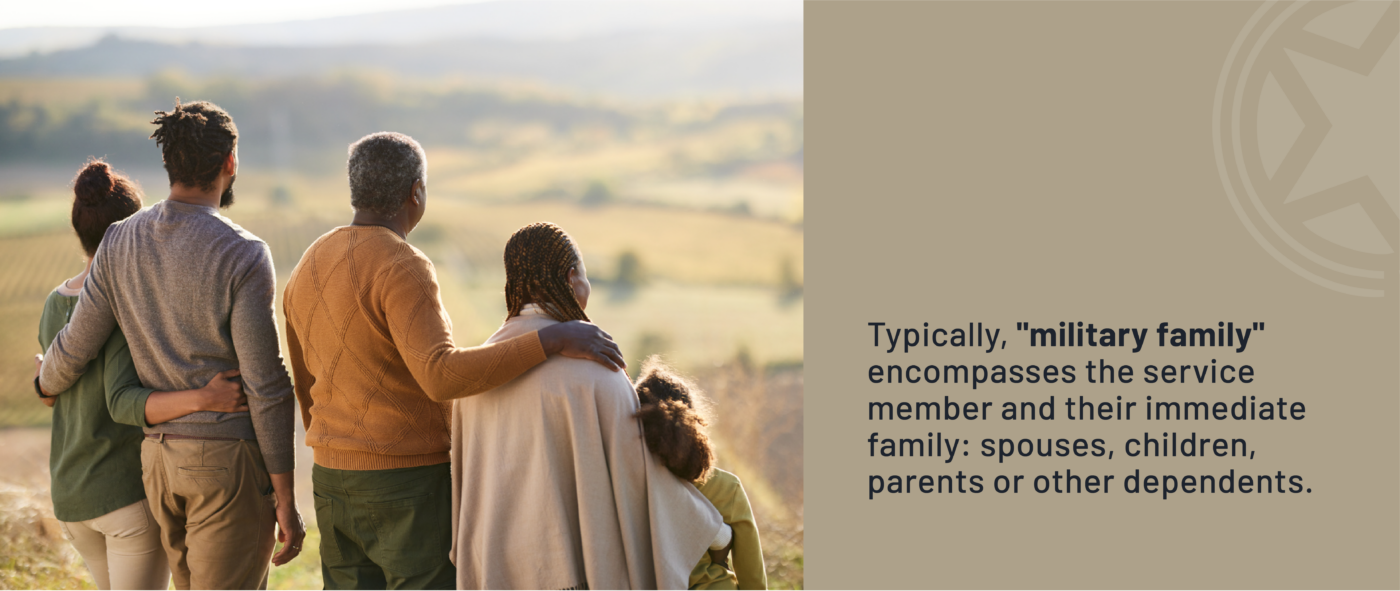
However, extended relatives or other loved ones are often impacted by their family member’s service in other ways. While these relatives are not typically defined as military families, their perception of the U.S. military is often greatly impacted by their family member’s personal experiences during and after their service. They may also be more likely to have strong opinions about active duty and veteran issues because of their proximity to the impact of these policies on their loved ones.
Who are these military families?
Military families span all U.S. Armed Forces and span diverse geographies, backgrounds, and demographics. In total, there are 2 million active component and Selected Reserve service members, with more than 1.6 million dependents. By service branch, the breakdown of service members in 2022 is as follows:
- Almost half of all service members are in the Army, with 22% in the Active Component, 16% in the National Guard, and an additional 9% in the Reserve;
- 24% of service members are in the Air Force, with 16% in the Active Component, 5% in the National Guard, and 3% in the Reserve;
- 19% of service members are enlisted in the Navy, with 16% Navy Active Component and 3% in Reserve;
- 10% of service members are in the Marine Corps, with 8% in the Active Component and the remaining 2% in Reserve.
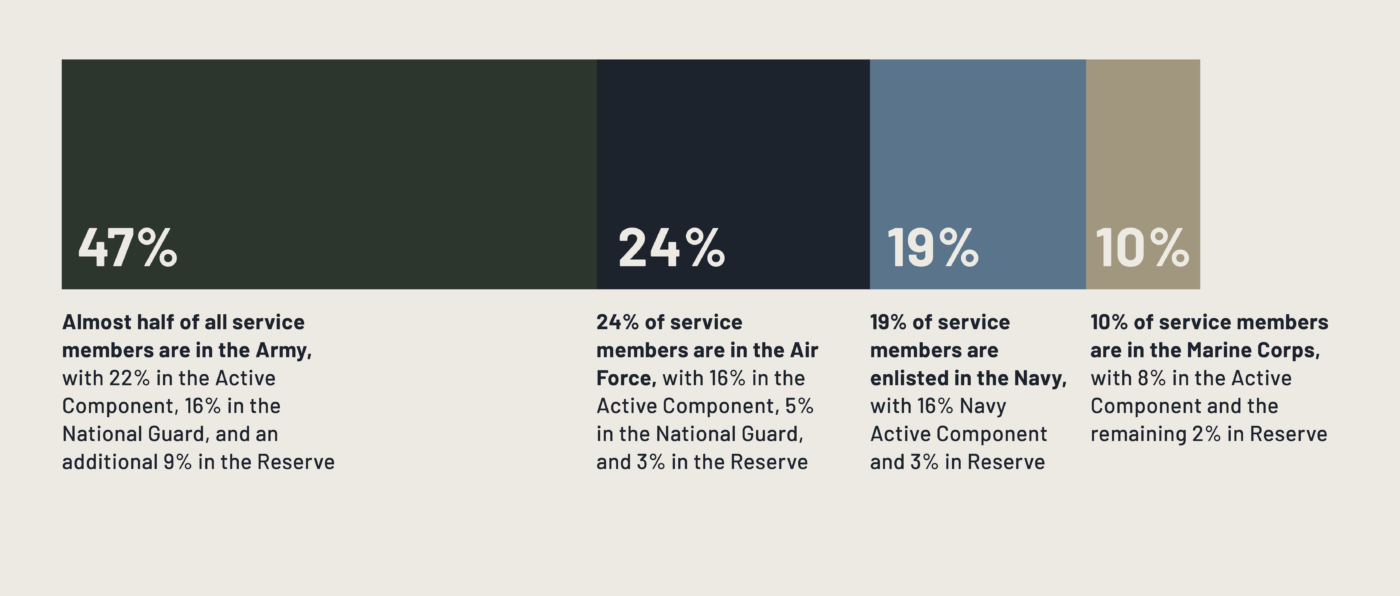
Service members’ assignments as active duty or reserves heavily affect the location of their military families. For those based in the United States, active service members are typically assigned to new bases every 2 to 3 years, resulting in continual transition for their families. By contrast, reserve service members generally maintain a continuous affiliation with a unit, and therefore their families face less relocation. Within the United States, active duty branches most heavily reside in California, Virginia, Texas, North Carolina, and Georgia. Similarly, most reserve units are located in Texas, California, Pennsylvania, Florida, and New York. As follows, these states tend to have large military family presence and transition. An additional 228,000 active duty personnel and 60,000 reserve personnel are stationed overseas.
Many of these service members are young men and women in early adulthood. Given the physical requirements and stressors of a career in the military, the force is structured to be built around a young demographic; the minimum age for entering military service is 17 and the maximum age is 42. Because service members skew strongly into those in young adulthood, many major milestones such as marriage and having children occur while they are in the peak years of their military career.
Half of the service member population is married, and 40% have children. Single parents make up 3.9% of active duty families and 8.5% of reserve and guard families. Additionally, 7% of active duty service members and 2.6% of the reserves and guard populations are in dual-military marriages. These conditions often require additional childcare, employment needs, and financial strain.
While there are about 1 million military spouses, nearly 10% of which are male, there are more than 1.6 million military children. Of the children in the K-12 age range, 80% attend public schools, meaning their school year is often interrupted during relocations. Frequent changes in school, childcare providers, and long stretches of time with a parent deployed can cause military children to face greater than average stress levels.
Military families who currently have a family member serving in the military, guard, reserves, or who are veterans are called Blue Star families. Silver Star families are classified by having a family member who is a wounded, ill, and/or injured veteran from any branch of the armed forces. Gold Star families are those who have lost a loved one during active duty service in any of the military branches and during any conflict. Lastly, Green/White Star families are families who have experienced a military member loss through suicide from any branch of service.
What are the biggest challenges facing military families?
The biggest challenges that military families face are: frequent relocation, military spouse underemployment or unemployment, and childcare. These interrelated issues often come with additional stressors as families have to consistently reacclimate to new environments, community and school groups.
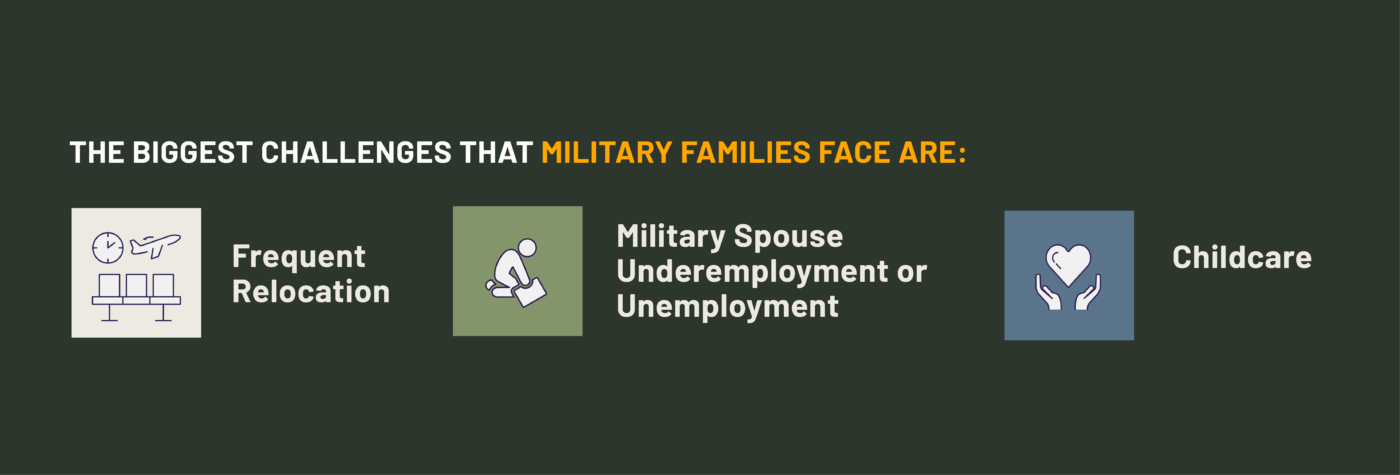
Military families are subject to frequent relocation. Each year, about one-third of all service members and their families are given a Permanent Change of Station (PCS) order to move to a new post, where they will typically stay for two to four years. Summer transitions are most common with the majority of these moves occurring between May and September, in what is referred to as PCS season, since it is in between school years for children. However, about 400,000 service members receive PCS orders in December and January, forcing their children to transfer schools in the middle of a school year.
These PCS orders will include a “Report No Later Than Date” for the service member to check in at their new assignment, which puts pressure on their military families to pick new schools, get new jobs, find new homes, secure child care, and settle into a new community typically within around 120 days. Oftentimes, military families will stay in a hotel or temporary housing until they can purchase a home in the area or get assigned a home on base. This puts unnecessary and extreme stress on military spouses.
In addition to organizing a move for the family, military spouses also need to search for new employment. Given the frequency at which military families move, military spouses have long faced employment challenges with an unemployment rate that soared to 38% after the COVID-19 pandemic. The unemployment rate among military spouses is five times the national average, which one in five military families cited as a reason for leaving active duty service.
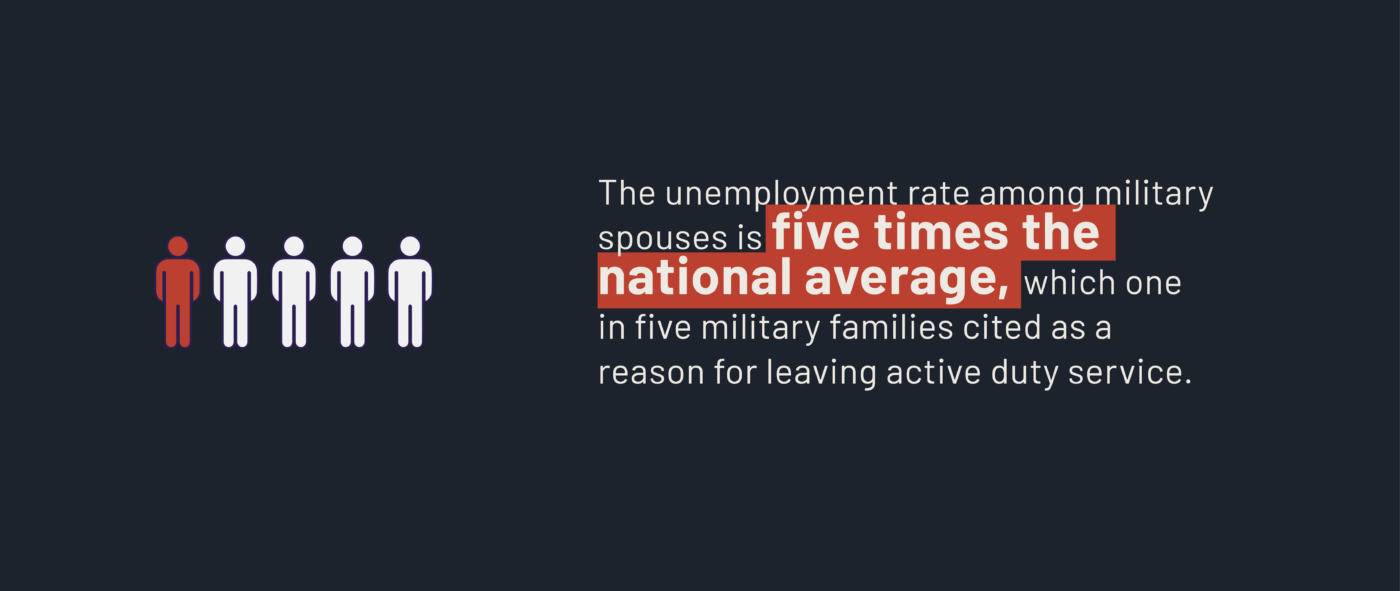
Due to the nature of PCS orders, military spouses are typically not awarded unemployment benefits since they “voluntarily leave” their jobs. While some U.S. states have military family benefits that allow spouses to receive unemployment compensation for moving along with their active-duty partner due to PCS orders, this compensation may not equate to a full-time salary and still necessitates that the military spouse sacrifice or delay career goals in order to accommodate the PCS orders.
Additionally, there are 14.3 million caregivers to service members and veterans, representing 5.5 percent of the U.S. adult population. Seventy percent of these caregivers are military spouses who are responsible for assisting their partners with daily activities and medical tasks. This takes a heavy mental and financial toll on military spouses.
For caregivers and employed spouses, child care is often a necessity. As a result, the Department of Defense provides on-base child care for military children. However, the COVID-19 pandemic triggered a shortage of childcare providers, and it falls on military families to come up with ways to overcome this gap. In May, 9,000 children were waiting months for spots at one of the military’s child care centers.
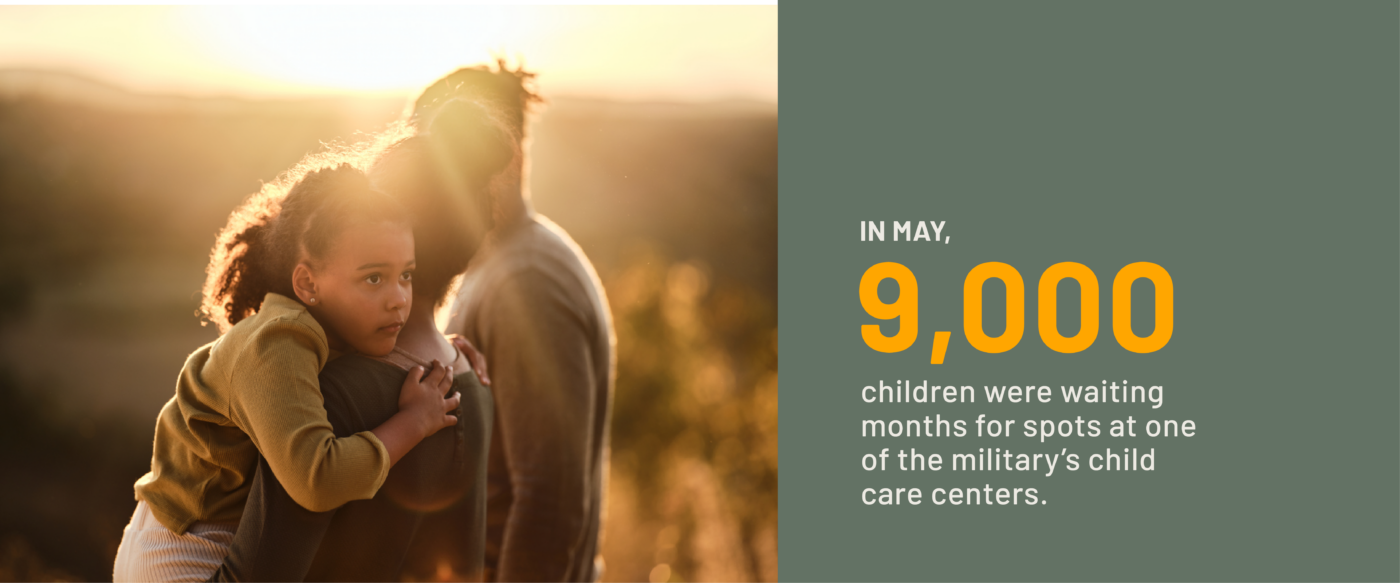
Amid all of the logistical stressors military families are subject to during relocation, many also experience difficulties adjusting to their new communities: spouses are often isolated from close friends and family and must frequently develop new relationships with other parents or coworkers; children must meet new friends at school; and families have to reestablish routines such as finding doctors, babysitters, and even new traffic routes and grocery stores. These factors can be further exacerbated for PCS families that move to installations designated as “remote and isolated.” These areas are far from urban centers and transportation access, adding to the difficulty of seeing friends and family or growing a new community.
What resources are available to military families?
Federal and state governments, nonprofit organizations, and private companies all work to provide resources and support for military families.
Organizations such as the Semper Fi & America’s Fund and Military One Source are comprehensive resources that provide access to information on family life, deployment, benefits, transition programs, counseling services, and more. Families can also find information in the National Resource Directory, a database that connects wounded warriors, service members, veterans, their families, and caregivers to programs and services that support them.
For health and wellness, TRICARE provides comprehensive medical, dental, and mental health services. Veterans can also access health care through the VA Medical Benefits. Additionally, families may qualify for food assistance through federal programs such as SNAP.
Organizations such as the Army Emergency Relief, the Navy-Marine Corps Relief Society, and the Air Force Aid Society provide financial aid, grants, and interest-free loans. Military OneSource’s MilTax offers free tax services for members of the National Guard and Reserves, immediate family members, and eligible survivors.
For education and childcare, the Post-9/11 GI Bill offers educational benefits to service members, veterans, and their dependents. The Military Child Education Coalition supports military children in schools, and School Liaison Officers assist families in navigating school systems at military installations. Child development centers also provide affordable, high-quality child care on military bases, and the Family Advocacy Program offers support for domestic and child abuse prevention. The New Parent Support Program also provides home visits and parenting education.
For housing assistance, military families can access on-base housing or receive a basic housing allowance through the Department of Defense (DoD) to help cover off-base living expenses. Each military installation also has housing offices that offer guidance in finding suitable accommodations. Veterans who are homeless or are in danger of becoming homeless can contact the VA National Homeless Call Center at 877-424-3838.
Relocation and transition support are available through services like the Relocation Assistance Program, which helps families transition smoothly during a PCS move. Programs like Navy MWR – which offers fitness centers, sports leagues, and travel discounts – can provide military families with a sense of community. The USO also supports military families with their trademark entertainment programs such as USO entertainment tours.
Military families and veterans can access these resources either directly or through organizations that help to connect military families to the support networks they need.
Mission Roll Call has referred veterans and their families to several organizations over the years. For example, America’s Warrior Partnership (AWP) is a national nonprofit focused on helping veterans and their families access essential resources through local community programs. AWP partners with communities across the U.S. to connect military families with benefits, healthcare, housing, and employment services. Military and veteran families can access assistance via this link or by contacting the AWP Network Support Line at 1-866-297-8397.
What are the challenges of transitioning from military to civilian life?
Despite the availability of various resources, military personnel often face significant challenges when transitioning to civilian life. Veterans report difficulties in finding employment, maintaining mental and physical health, and achieving stability in financial and social domains.
A recent Mission Roll Call poll highlights these struggles. When asked, “What was the hardest part of your transition from military service?” 30.26% of respondents identified the VA process, 26.48% mentioned finding a job, and 28.05% pointed to establishing a routine. Alarmingly, only 15% of veterans felt that the military’s transition assistance program adequately prepared them for entering the civilian workforce.

The challenges extend to healthcare as well. Just 40% of veterans expressed satisfaction with the VA’s approach to treating post-traumatic stress, a condition that affects millions of war survivors worldwide. This dissatisfaction suggests a gap in the support provided to veterans coping with the psychological toll of military service.
Financial stress is another critical issue. According to a 2021 report, more than three-quarters (75.8%) of military and veteran families carry debt, and more than 80% experience financial stress. This economic strain compounds the mental health challenges veterans face, often increasing their risk of homelessness—a problem that saw a 7.4% rise in 2023.
Together, these difficulties highlight the need for more effective support systems to ensure veterans and their families can transition successfully into civilian life.
What policies exist to support military families?
Several bills have been introduced to or passed by Congress that aim to support military families by addressing key challenges like employment, housing, childcare, and healthcare. For example, The Military Family Stability Act, which was introduced to the House of Representatives in 2017, is designed to provide greater flexibility during relocations, reducing disruptions to employment and education. By giving families more time between relocations and additional support before, during, and after the relocation process, the Act would help ensure that when service members and their families do need to relocate for military service, they are able to do so sustainably and maintain stability.
In addition, The Military Spouse Employment Act would improve job opportunities for spouses by offering job training, remote work options, and hiring incentives for businesses. After passing the Senate in June 2023, the bill is now under consideration in the House of Representatives. Currently, appointment authority for military spouses does not include remote work, limiting their career flexibility. By addressing this gap, the Act would expand career options and improve financial stability for military families.
Mental health is a focus of the Veterans Mental Health and Addiction Therapy Quality of Care Act, which seeks to address the quality of care provided by healthcare providers of the Department compared to non-Department providers.
These policies would augment the existing provisions and legislative support that exists for military families. For example, the Military Child Care Act of 1989 addressed childcare by allocating $157 million for childcare services (equivalent to $356 million today), introducing minimum safety and accreditation standards for military child care centers, requiring staff background checks, and implementing a standardized priority and fee system.
The Veterans Housing Stability Act tackled housing issues by helping veterans and active service members with VA home loans exit forbearance, get their mortgage payments back on track, and stay in their homes. Similarly, the Mental Health for Military Families Act enables the Secretary of Defense to waive out-of-pocket costs for military families under TRICARE for their first three outpatient mental health visits each year, reducing expenses and making it easier for families to access necessary care
Additionally, in March of 2020, the Immigration and Nationality Act (INA) was signed into law to aid undocumented family members of service members by allowing them to apply for legal status without leaving the U.S. The policies aim to recognize the significant contributions of immigrant military personnel and provide them, and their families, with a faster path to citizenship.
Policy reform can have a significant impact on military families. While these bills show some of the major strides that the federal government has made to support service members and their families, there is still much to be done to ensure military families have the support they deserve.
How can you help support military families?
There are many ways you can support military families, either through personal actions, community involvement, or advocacy.
Ways to support:
- Volunteer: Join organizations that support military families, such as the USO, Blue Star Families, or local family readiness groups. Volunteering your time to assist with events, childcare, or providing other services can make a meaningful difference. Mission Roll Call offers a comprehensive Veteran Nonprofits list to help you get started.
- Donate: Contribute to charities that help military families, such as Operation Homefront, which provides emergency assistance and housing support, or Fisher House Foundation, which offers free lodging for families near military hospitals.
- Advocate for Legislation: Support bills to improve the quality of life for military families by exercising your right to vote, considering outreach to your representatives if this issue is of interest, joining advocacy groups, or spreading awareness on social media.
- Offer Employment Opportunities: If you’re an employer or know someone hiring, consider offering jobs or remote work options to military spouses, who often face challenges finding and retaining employment due to frequent relocations.
- Provide Childcare or Mentorship: Help military families by offering babysitting, tutoring, or mentorship to military children, who endure considerable stress from parental deployments and frequent moves.
- Raise Awareness: Use your voice on social media, in your community, or by participating in advocacy polls to raise awareness about the unique challenges military families face and advocate for better support systems, both locally and nationally.